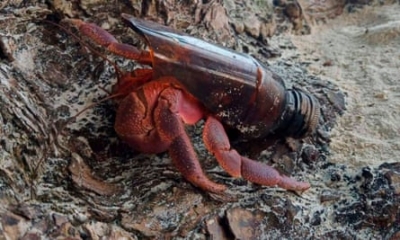
The Mu Koh lanta national park in Southern Thailand had a rather unusual appeal to make to the public. The park authorities requested the public to donate cone-shaped shells they may have to the hermit crabs that have boomed in the last few months in the park. The population of the crustaceans, which protect themselves by wearing and living inside the discarded shells of other animals such as sea snails, has exploded on some islands in the Mu Koh Lanta national park Marine biologists believe the lack of visitors to the park in the backdrop of the COVID-19 pandemic could be a contributing factor. They feel that low number of tourists means fewer activities in the coastal areas, which could have led to the high survival rates of the hermit crabs.
As tens of thousands of hermit crabs thrive on the island, there is a serious shortage for shells. Some hermit crabs, having outgrown their previous homes, have moved into pieces of rubbish such as plastic cans, bottles, or caps. While going without a shell make them extremely vulnerable to their predators, living inside plastic homes is not safe either. The hermit crabs that climb into plastic bottles find the surface too slippery to get traction. Therefore, they cannot climb out of them. A 2020 study found that around 570,000 hermit crabs die annually from getting caught in plastic debris on two tropical islands in the South Pacific.
Plastic debris, in fact, creates a cascade of death for hermit crabs, because when a hermit crab dies, it releases chemical signal to other crabs conveying that its shell is available for occupation. This lures other crabs into the plastic container. One after the other hermit crabs get into the bottle or plastic can thinking they will get their next home, when in reality, it’s their last home.
Have you heard of the vacancy chain?
Hermit crabs begin their lives in larval forms on the seafloor. The larvae eventually metamorphose into small crabs, at which time they must search for their own shells. Hermit crabs are not true crabs – they do not grow their own shells, instead they have hard exoskeleton in the front and soft body in the back, which they protect using the discarded shells of other animals. As the hermit crab grows in size, it must find a larger shell and abandon the previous one.
These social animals display a fascinating behaviour when they are out to look for a new shell. At least 20 individual hermit crabs line up in size order – biggest to smallest – to see if a new shell turns up and who fits into it best. Their curled tail with a hook enables their bodies to fit inside these borrowed shells. Once a member fits into a new shell, it will eject itself from its former calcified castle and the next smallest will take this hand-me-down home, while leaving its older one for another and so on – the aim is that everyone walks away with a new shell that is a better fit than their old one! Scientists call this the vacancy chain.
Picture Credit : Google

